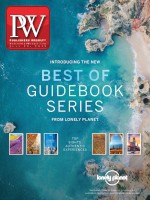In the decades following the storied beginnings of Lonely Planet and Moon, when their traveling founders passed around mimeographs of their typed-up notes and crudely drawn maps, guidebooks largely stuck to the same format—maximum, densely packed information punctuated by compressed images.
Today, comprehensive guides—those that cover an entire country or cluster of countries—typically remain text-heavy affairs. Meanwhile, travel upstarts seek to attract readers with a focused mix of substance and style, and longtime guidebook publishers are putting more of an emphasis on visuals in series outside of their core offerings.
“It’s really important to have something that’s practical and useful,” says Anna Chittenden, who writes the Lost Guides series. “But practical doesn’t mean it can’t be beautiful.”
Chittenden moved from London to Singapore in 2014 and launched her series the following year with Lost Guides: Bali. A Singapore book followed in 2017; both titles were distributed in the U.K. and Asia. In October, Cardinal Publishers Group is bringing Lost Guides to the U.S. with the latest editions of the Bali and Singapore books, as well as the new Lost Guides: Tokyo & Beyond, which is publishing ahead of an expected uptick in tourism thanks to the 2020 Olympics.
Part of the impetus behind the series, Chittenden says, is that she didn’t feel any existing guidebooks spoke to her “generation of traveler”—people who, as she writes in Tokyo & Beyond, are at the point in their lives when they “don’t require over-the-top extravagance but can stretch beyond the budget of a backpacker.” For each guidebook, she compiles 120–150 of her favorite things to see and do in each destination, with at least one photo per entry, as well as information including addresses, Instagram handles, hours, and public transportation information. “If you’re in Bali without internet,” she says, “you’re still okay with just this book.”
Including those details makes the guides more than just “beautiful to look at,” Chittenden says, but she’s unequivocal about the importance of visual appeal. “Posting books on social media is the new word-of-mouth,” she says. “The covers have to be really appealing to encourage people to post them.”
Show and Tell
London’s Amber Books, best known for history and military titles, is venturing into travel publishing with its new Visual Explorer Guide series. Sterling will distribute the books in the U.S., beginning in August with guides to Iceland, Italy, and Paris.
The guides emphasize visual representation and cultural context over trip-planning nitty-gritty. “Iceland is as much about its history and people as its landscape,” Chris McNab writes in the book’s introduction, before going on to depict the local
culture as it’s embodied in architecture, art, food and more.
An entry on Icelandic wool, for instance, shows a close-up of a colorful array of knee-high socks for sale, with accompanying text explaining that fleece consists of two layers of wool, tog and pel, resulting in a material that is both warm and waterproof, “perfect for the sub-zero winters.”
Books in the series were developed to be attractive gift items, says Charles Catton, editorial director at Amber Books, designed in a pocket-size format so that the traveler can carry them along for reference. After the first titles, books on Canada, Egypt, and Thailand are planned for spring 2020. “We’re not trying to compete with Lonely Planet,” Catton says. “We see ourselves as an adjunct.”
For its part, Lonely Planet is taking a selective approach with its Best Of series, coming to the U.S. in August. Darren O’Connell, product director at Lonely Planet, says the line’s “more stylized” covers, which sport Polaroid-like white margins and a slimmed-down, all-caps font, immediately distinguish its books from the publisher’s more comprehensive blue-spine guides.
Originally called the Discover series when it launched in 2010, the line distills each locale down to the 12 best destinations or experiences. In May 2016, the books were rebranded as Best Of and given a new look for the U.K. and Australia. “We’ve made a few choices for the traveler,” O’Connell says. “People want to know what a place is like, and the visual content helps them decide where they want to go.” Such visual storytelling was less important when the Discover series was being developed, he says, “but it’s certainly picking up now.”
The revamp resulted in stronger sales in Australia and the U.K., O’Connell says, so now Lonely Planet is bringing the U.S. market into the fold. Best Of titles that originated in the Discover series include Barcelona, Malaysia and Singapore, Peru, Rome, and Tokyo; forthcoming destinations include Central America, Iceland, and South America.



 Volume 266
Issue 30
07/29/2019
Volume 266
Issue 30
07/29/2019





